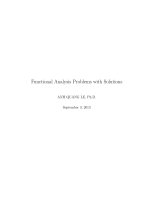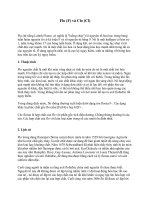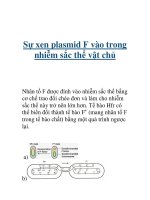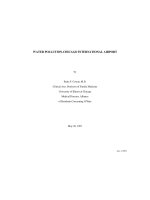Howard f lyman, glen merzer mad cowboy plain truth from the cattle rancher who wont eat meat scribner book company (2001)
Bạn đang xem bản rút gọn của tài liệu. Xem và tải ngay bản đầy đủ của tài liệu tại đây (1.87 MB, 225 trang )
Plain Truth from the Cattle Rancher
Who Won’t Eat Meat
HOWARD F. LYMAN
with
GLEN MERZER
This book is the work of Howard Lyman and Glen Merzer.
The publication of this book is not affiliated with,
nor endorsed by, the Humane Society
of the United States.
SCRIBNER
www.pdfgrip.com
www.pdfgrip.com
Plain Truth from the Cattle Rancher
Who Won’t Eat Meat
HOWARD F. LYMAN
with
GLEN MERZER
èáÃ- ắà Ã- ơáằ âđà ỉâđẳ ễĐ ẳ ằ ểằđƯằđũ
The publication of this book is not affiliated with,
nor endorsed by, the Humane Society
of the United States.
SCRIBNER
www.pdfgrip.com
For Willow
Jeane
with love
SCRIBNER
1230 Avenue of the Americas
New York, NY 10020
Visit us on the World Wide Web:
Copyright © 1998 by Howard Lyman and Glen Merzer
All rights reserved, including the right of reproduction
in whole or in part in any form.
SCRIBNER and design are registered trademarks of
Simon & Schuster Inc.
Designed by Colin Joh
ISBN 0-7432-1905-8
www.pdfgrip.com
ACKNOWLEDGMENTS
We would like to express our thanks to Charles Attwood, Ronnie
Cummins, Richard DeAndrea, Reed and Prem Glidden, Michael
Hansen, Susanne Havala, Matt and Mary Kelly, Michael Klaper,
and John Stauber, for their advice, insight, and support. We are
indebted as well to Gillian Blake for a brilliant job of editing, to Rick
Rever and Steve Lustgarden for their suggestions, to Hans and
Coby Seigenthaller for their endless hospitality, and to Marr Nealon
and Patti Breitman for making this book possible. Erik Marcus
deserves thanks not only for his thoughtful comments, but for writing
the superb Vegan:The New Ethics of Eating. And we wish to
acknowledge here gratefully an unsung hero of the environmental
movement, Lynn Jacobs, whose extraordinary book, Waste of the
West: Public Lands Ranching, is the most meticulous, carefully
researched, comprehensively told story of what has happened to
the ecology of the western United States. A special note of thanks
as well to John Robbins, as generous a spirit as walks the earth.
Finally, eternal gratitude to our wives, Willow Jeane Lyman and
Joanna Samorow-Merzer, for putting up with us.
www.pdfgrip.com
www.pdfgrip.com
CONTENTS
1. HOW TO TELL THE TRUTH AND GET IN TROUBLE
11
2. THE SIMPLE FACTS
21
3. IMPROVING ON NATURE
47
4. FROM THE FARM TO THE CAPITAL
61
5. MAD COWS AND BUREAUCRATS
82
6. BIOTECH BULLIES
102
7. BOVINE PLANET
121
8. SKIP THE MIRACLES AND EAT WELL
154
9. GOING HOME
184
ENDNOTES
191
BIBLIOGRAPHY
207
INDEX
215
www.pdfgrip.com
www.pdfgrip.com
Mad
Cowboy
www.pdfgrip.com
www.pdfgrip.com
CHAPTER O NE
How to Tell the Truth and
Get in Trouble
I am a fourth-generation dairy farmer and cattle rancher. I grew up
on a dairy farm in Montana, and I ran a feedlot operation there for
twenty years. I know firsthand how cattle are raised and how meat
is produced in this country.
Today I am president of the International Vegetarian Union.
Sure, I used to enjoy my steaks as much as the next guy. But if
you knew what I know about what goes into them and what they
can do to you, youd probably be a vegetarian like me. And, believe
it or not, as a pure vegetarian now who consumes no animal products
at all, I can tell you that these days I enjoy eating more than ever.
If youre a meat-eater in America, you have a right to know that
you have something in common with most of the cows youve eaten.
Theyve eaten meat, too.
When a cow is slaughtered, about half of it by weight is not
eaten by humans: the intestines and their contents, the head, hooves,
and horns, as well as bones and blood. These are dumped into giant
11
www.pdfgrip.com
M AD C OWBOY
grinders at rendering plants, as are the entire bodies of cows and
other farm animals known to be diseased. Rendering is a $2.4billion-a-year industry, processing forty billion pounds of dead animals
a year. There is simply no such thing in America as an animal too
ravaged by disease, too cancerous, or too putrid to be welcomed by
the allembracing arms of the renderer. Another staple of the
renderers diet, in addition to farm animals, is euthanized petsthe
six or seven million dogs and cats that are killed in animal shelters
every year. The city of Los Angeles alone, for example, sends some
two hundred tons of euthanized cats and dogs to a rendering plant
every month. Added to the blend are the euthanized catch of animal
control agencies, and roadkill. (Roadkill is not collected daily, and in
the summer, the better roadkill collection crews can generally smell
it before they can see it.) When this gruesome mix is ground and
steam-cooked, the lighter, fatty material floating to the top gets
refined for use in such products as cosmetics, lubricants, soaps,
candles, and waxes. The heavier protein material is dried and
pulverized into a brown powderabout a quarter of which consists
of fecal material. The powder is used as an additive to almost all
pet food as well as to livestock feed. Farmers call it protein
concentrates. In 1995, five million tons of processed slaughterhouse
leftovers were sold for animal feed in the United States. I used to
feed tons of the stuff to my own livestock. It never concerned me
that I was feeding cattle to cattle.
In August 1997, in response to growing concern about the spread
of bovine spongiform encephalopathy (or Mad Cow disease), the
FDA issued a new regulation that bans the feeding of ruminant
protein (protein from cud-chewing animals) to ruminants; therefore,
to the extent that the regulation is actually enforced, cattle are no
longer quite the cannibals that we had made them into. They are no
12
www.pdfgrip.com
How to Tell the Trouth and Get in Trouble
longer eating solid parts of other cattle, or sheep, or goats. They still
munch, however, on ground-up dead horses, dogs, cats, pigs, chickens,
and turkeys, as well as blood and fecal material of their own species
and that of chickens. About 75 percent of the ninety million beef
cattle in America are routinely given feed that has been enriched
with rendered animal parts. The use of animal excrement in feed is
common as well, as livestock operators have found it to be an efficient
way of disposing of a portion of the 1.6 million tons of livestock
wastes generated annually by their industry. In Arkansas, for
example, the average farm feeds over fifty tons of chicken litter to
cattle every year. One Arkansas cattle farmer was quoted in U.S.
News & World Report as having recently purchased 745 tons of
litter collected from the floors of local chicken-raising operations.
After mixing it with small amounts of soybean bran, he then feeds
it to his eight hundred head of cattle, making them, in his words, fat
as butterballs. He explained, If I didnt have chicken litter, Id
have to sell half my herd. Other feeds are too expensive. If you
are a meat-eater, understand that this is the food of your food.
We dont know all there is to know about the extent to which the
consumption of diseased or unhealthy animals causes disease in
humans, but we do know that some diseasesrabies, for example
are transmitted from the host animal to humans. We know that the
common food poisonings brought on by such organisms as the
prevalent E. coli bacteria, which results from fecal contamination
of food, causes the death of nine thousand Americans a year and
that about 80 percent of food poisonings come from tainted meat.
And now we can also be virtually certain, from the tragedy that has
already afflicted Britain, that Mad Cow disease can jump species
and give rise to a new variant of the always fatal, brain-wasting
Creutzfeldt-Jakob disease in humans.
13
www.pdfgrip.com
M AD C OWBOY
A funny thing can happen when you tell the truth in this country.
You can get sued. In April of 1996, I was sitting on the stage of The
Oprah Winfrey Show, looking into the shocked faces of a studio
audience that was learning for the first time that we were turning
cows into cannibals. Right now, I explained, were following
exactly the same path that they followed in Englandten years of
dealing with [Mad Cow disease] as public relations rather than doing
something substantial about it. A hundred thousand cows per year
in the United States are fine one night, then [found] dead the following
morning. The majority of those cows are . . . ground up and fed
back to other cows. If only one of them has Mad Cow disease, it
has the potential to affect thousands. Oprah herself was taken
aback, and said quite simply, Cows are herbivores. They shouldnt
be eating other cows. . . . It has just stopped me cold from eating
another burger.
Sitting next to me on the stage was a representative of the
National Cattlemens Beef Association, Dr. Gary Weber, whose
job it was to reassure the viewing public of the absolute safety of
meat. I felt sorry for the guy; he had an extremely difficult hand to
play. He couldnt deny my assertion that wed been feeding cows
to cows, but belittling the fact didnt sit well with a gasping audience.
During commercial breaks he privately agreed with me that we
shouldnt be adding chopped-up cow to animal feed.
In early June, a suit was nonetheless filed on behalf of a group of
Texas cattlemen, naming not only me but Oprah and her production
company, Harpo Productions, as joint culprits in Food Disparagement.
The Texas cattlemen and the Texas Commissioner of Agriculture
apparently believe that the First Amendment to the Constitution of
the United States, guaranteeing freedom of expression, was not
meant to be interpreted so broadly as to allow people to say
14
www.pdfgrip.com
How to Tell the Trouth and Get in Trouble
unpleasant things about beef. Pointing to a drop in the cattle futures
market, the plaintiffs charged me with making slanderous
statements about cattle and beef that caused them to endure shame,
embarrassment, humiliation, and mental pain and anguish. Under
Texass Food Disparagement law, the burden of proof rests, to a
great extent, on the shoulders of the defendants. In January 1998, a
jury was convened in Amarillo, Texas, to determine, among other
things, whether my statements deviated from reasonable and reliable
scientific inquiry, fact, or dataa standard of proof that seems
remarkably oblivious of the fact that disagreement has always
existed within the scientific community itself on most matters of
importance, and certainly exists now on the matter of Mad Cow
disease. Controversy even erupted in nineteenth-century Hungary
when Dr. Ignaz Philipp Semmelweis suggested that medical students
delivering babies should wash their hands firstespecially as many
of them had come to the delivery room after dissecting corpses.
The man was roundly attacked for this radical view, but at least he
didnt have to face any Germ Disparagement laws.
Thirteen states have Food Disparagement laws on the books. In
Colorado, convicted food disparagers can even be sent to jail. These
laws represent the most concerted attack on First Amendment
freedoms in at least a generation, and effectively put consumer
advocates on notice that anything they may have to say concerning
the safety of any aspect of our food supply could bring a bankrupting
lawsuit smashing down on their heads.
Oprah and I have the distinction of being the first individuals
sued under the Texas Food Disparagement Act. More than a year
after we were sued, the second lawsuit premised on the law was
filedby emu ranchers against the Honda Motor Company, whose
television commercials they felt poked fun at emus. Emu prices
15
www.pdfgrip.com
M AD C OWBOY
had been plummeting for years, and I have a sneaking suspicion
that the emu ranchers were secretly pleased to find an entity like
Honda with deep pockets to blame it on. It seems that, in Texas at
least, you cant be too careful what you say about cattle and emus.
Within a few months after the Oprah show aired and caused a
firestorm of controversy, the Food and Drug Administration
announced pending regulations to eliminate the feeding of ruminants
to ruminants. The specific content of the regulations was delayed
until after the presidential elections of 1996, most likely to avoid
offending the livestock industry. Finally, the August 1997 ban on
feeding ruminants to ruminants, a necessary but insufficient measure
to stave off the spread of Mad Cow disease to America, went into
effect.
Most of the media outlets in this country generate significant
advertising revenues from the meat and dairy industries. After the
Oprah show aired, I learned that the Beef Promotion Council pulled
over six hundred thousand dollars worth of network advertising.
Its rare to find a media power player like Oprah, with the guts and
the integrity to be willing to take on the big boys. Ill never forget
that on the day of the show, Oprah told me privately that she had
seen the movie Babe several times and would never eat pork again.
During the show, she appeared to give up beef.
If youre going to be sued for disparaging beef, common sense
alone would tell you to choose any setting other than Amarillo, Texas,
for the site of the trial. Amarillo positively reeks of cows; the beef
industry is a $3-billion-a-year industry there. Twenty-five percent
of U.S. cattle are fattened in Amarillo feedlots before going to
market. The towns biggest private employer is a slaughterhouse.
A mural of cattle adorns the courthouse above the elevator. Amarillo
is also the hometown of Paul Engler, a feedlot owner who was one
16
www.pdfgrip.com
How to Tell the Trouth and Get in Trouble
of the plaintiffs in the lawsuit. An internal memo distributed by the
president of the Amarillo Chamber of Commerce almost two weeks
before the trial began reminded all concerned that the chamber
fully supports the cattle feed industry and that there should be no
red carpet rollouts for Oprah Winfrey. For all those reasons, our
respective attorneys filed a pretrial motion asking that the trial be
given a change of venue from Amarillo to the more neutral territory
of Dallas. The motion was denied. My attorney took that as a legal
setback, and an indication that the judge was hostile to our side, but
I was secretly pleased. I liked the idea of giving my opponents their
best shot. Let them have the hometown advantage, I thought. If
Oprah and I prevailed, the victory would be all the sweeter.
Oprah could have easily afforded to pay the millions of dollars
she was being sued for, but to her credit she fought both for her
reputation and for freedom of speech, and moved her television
show from Chicago to Amarillo for the trial. Reporters followed
her like flies to a feedlot. Neither she nor I could step up to the
microphones, however, as Judge Mary Lou Robinson had imposed
a gag order on all parties for the duration of the trial. Day after day
on the news, Oprah could be seen shrugging in uncharacteristic
muteness at the cameras as she entered and left the courthouse.
For some reason, the press showed less interest in me, and I can
state unequivocally that absolutely no member of the press
whatsoever showed any interest at all in what I was wearing.
I was on the witness stand for two days. Since the Food
Disparagement law on which the plaintiffs case was premised
makes a person liable if he or she knowingly gives information that
states or implies that a perishable food product is not safe for
consumption by the public, and that information is judged to be
false according to reasonable and reliable scientific inquiry, facts,
17
www.pdfgrip.com
M AD C OWBOY
or data, the plaintiffs attorney had to first establish that I had
disseminated certain facts. He would then have to prove that
those facts were false, and that I had known they were false.
But I simply denied that my warnings of the dangers of Mad Cow
disease spreading to the States were facts at all. I repeatedly
said I was expressing only my opinion. And while I firmly believe
that my warning that the practice of cow cannibalism could have
tragic consequences falls into the category of opinion rather than
facthow, after all, can there be a fact about the future?the
idea that millions of dollars worth of liability should rest on such
distinctions endangers healthy debate in a free society. The exercise
I went through on the stand simply has no place in the America that
I believe in. I had to answer questions such as, Has anyone ever
said you were irresponsible? I was under oath, in a court of law. I
couldnt lie. My wife, I said.
When Oprah took the stand, she called the lawsuit the most
painful thing Ive ever experienced. Then she added, I feel in my
heart Ive never done a malicious act against any human being. I
believe her. Throughout the trial, inside and outside the courtroom,
I never heard her say an unkind word about anyone, even the
cattlemen who had attacked her reputation for integrity. I just dont
understand why Im here, she often said. As she pointed out on
the stand, she had invited two guests on the show to present the
beef industrys point of view. She had even allowed one of them,
Dr. Weber, to return for a follow-up show, without me or any other
food safety activist present to counter his claims. Oprah could hardly
be fairly accused of harboring an anti-beef agenda, and yet here
she was in Amarillo, accused of just that.
Mr. Engler, our accuser, took the stand and testified that he might
not have filed suit if I had qualified my statements on the air as
18
www.pdfgrip.com
How to Tell the Trouth and Get in Trouble
simply my opinions. He said that Dr. Weber was not under any
such obligation to qualify his statements because he had more
credibility by virtue of having a Ph.D. and not being a vegetarian.
My attorney pointed out that Engler and I had some things in
common: both of us have bachelors degrees in agriculture, and
both of us became cattlemen who once sold off our cattle to cover
debts. Therefore, my attorney asked, If you appeared on a national
talk show, would you have to say that you were expressing an
opinion?
No, Engler answered.
Is the main difference between you and Mr. Lyman that you
dont agree with him? my attorney asked.
No, sir. Its difficult to say, Engler said. He paused, then
explained, Mr. Lymans a liar.
The jury didnt buy his logic. On February 26, 1998, the long
ordeal came to an end when the jury, after a deliberation that lasted
less than six hours, found us not liable for damages. It was a
wonderful day for me, full of the joy that comes of relief from
torment. But there are better kinds of joy, and I wouldnt wish the
experience of a potentially bankrupting lawsuit on my worst enemy.
I hope that the thirteen states that currently have food libel laws,
and the fourteen other states that are reported to be currently
considering enacting them, note that the trial became something of
a bad joke throughout the nation. And I hope and trust that these
laws will soon be found unconstitutional.
I can tell you as a former Alleged Food Disparager that behind
the absurdity of this lawsuit lay an ugly reality. The American people
have been raised to believe that someone is looking out for their
food safety. The disturbing truth is that the protection of the quality
of our food is the mandate of foot-dragging bureaucrats at the U.S.
19
www.pdfgrip.com
M AD C OWBOY
Department of Agriculture and the Food and Drug Administration
who can generally be counted upon to behave not like public servants
but like hired hands of the meat and dairy industries.
My journey from feedlot operator to cattlemens nemesis has
been a strange ride, one that has brought me from castrating calves
to experiencing the frustrations of Washington politics, from
embracing high-tech agriculture to getting sued by its practitioners.
I dont pretend to understand the meaning of every bump in the
road Ive traveled. Hell, I sometimes feel like I was unconscious
for the first half of the trip. But I can say this much for sure: all the
signposts along the way concerned my health. Every time I
instinctively made a choice consistent with the improvement of my
physical health, it was as if more light was shed to guide me on
what has turned out to be a marvelous path.
In writing this book, it is my purpose, more than anything else, to
share what Ive learned about how the best choices for our personal
health turn out to be the best choices for the world we inhabit.
For all too many Americans, the first decision they consciously
make about their health is the stark one between bypass surgery
and angioplasty, or between chemotherapy and radiation. In reality,
however, we knowingly or unknowingly make choices every day
that can either lead us toward those grim options, or else toward
happier ones. We do so, of course, every time we decide what fuel
to put in our bodies.
To make our choices informed ones, we have to start with the
facts.
20
www.pdfgrip.com
CHAPTER TWO
The Simple Facts
There are only two things wrong with meat: what we know for
sure is in it, and all the other stuff that might be in it.
Nearly all meat in America is contaminated with such man-made
carcinogens as dioxins, a family of chemicals related to Agent Orange, and DDT, the notorious chemical that was banned domestically over twenty-five years ago but that remains in the ground
(and will remain there, unfortunately, for thousands of years to come)
and therefore in the crops fed to animals. Crops grown for cattle
feed are permitted to, and almost always do, contain far higher
levels of pesticides than crops grown for human consumption. About
80 percent of pesticides used in America are targeted on four specific cropscorn, soybeans, cotton, and wheatthat are the major
constituents of livestock feed. Since animals store pesticides and
other toxic substances in their fat, they get their most concentrated
doses of these carcinogens when they eat other animals. And we in
turn get even more concentrated doses of carcinogens when we
eat them.
According to a 1975 study by the Council on Environmental Quality, 95 percent of the human intake of DDT came from dairy and
21
www.pdfgrip.com
M AD C OWBOY
meat products. When we dont eat animal products, we can largely
avoid pesticide residues. A study published in the New England
Journal of Medicine found that the breast milk of vegetarian
women had only 1 to 2 percent of the national average of pesticide
contamination.
Of course, there are many carcinogens in our environment, and
there is often a lag of ten or twenty or even thirty years before a
cancer-causing agent produces the full-blown tumor that can kill a
person, so it is always difficult to attribute any given cancer to a
particular source with anything approaching scientific certainty. But
we do know that the incidence of cancer in the human population,
and most notably in industrialized societies, has skyrocketed during
this century, and the increase continues unabated. When President
Nixon declared a national War on Cancer in 1971, about one in five
Americans could expect to be afflicted with cancer in their lifetimes.
Today, that figure is one in three. Many studies have implicated
pesticides as a major source of cancer risk. The evidence mounts
that farmers, who have greater contact with pesticides than the
general population, are suffering a disproportionate incidence of
cancer. As we go down the mine of chemical agriculture, our farmers
may unfortunately be serving as our canaries.
But there is a difference between established scientific fact and
speculation, even when that speculation centers on matters as
troubling as the feeding of animal parts and feces to the nations
livestock, and the hemisphere-sized experiment, just thirty years
old, of the prolific use of pesticides, in which humans as well as
farm animals have been the unwitting guinea pigs.
So let us set aside speculation for the moment and begin simply
from one indisputable scientific fact about flesh consumption: meat
22
www.pdfgrip.com
The Simple Facts
kills. It kills us just as dead as tobacco kills us, but far more frequently.
It is far and away the number-one cause of death and disease in
America. One out of every two Americans alive today will die of
cardiovascular disease, usually in the form of a heart attack. And
heart attacks are never caused by corn, broccoli, or cauliflower;
they are not the work of pears, plums, or peaches; they are never
brought on by rice, barley, or lentils. They can virtually always be
attributed to saturated fat and cholesterol. Since saturated fat is
converted by the liver into cholesterol, these two agents work hand
in hand. In excess, they begin clogging our arteries, causing
atherosclerosis, the major factor in heart disease. Although its
certainly possible to get too much fat from a select few plant-based
foods (oils, margarine, nuts, seeds, and avocados, for example),
most of the saturated fat in the standard American diet and all the
cholesterol come from animal products. Study after study has linked
the consumption of animal products to heart disease. When I say to
you that the consumption of meat, fish, poultry, and dairy products
is the primary cause of atherosclerosis in nonsmokers (for smokers,
cigarettes may be equally to blame), I am not just giving my opinion;
I am reporting a medical fact that has been established with as
much scientific unanimity and consistency as the fact that smoking
cigarettes dramatically increases the risk of lung cancer, emphysema,
and heart disease. But it is a fact that simply hasnt yet been
established as firmly in the public mind, thanks in large part to the
obfuscations of the meat and dairy industries, which have taken a
lesson from the tobacco industry in how to stay in business while
killing people. Their policy is simple: deny, and when you cant deny,
confuse. One of the most effective means of confusion has been to
imply to the American people that heart disease is a natural cause
23
www.pdfgrip.com
M AD C OWBOY
of death. But as the noted preventive health care expert Dr. Julian
Whitaker points out, Death of heart disease is as unnecessary as
dying of drug abuse, yet it is taken as a normal thing.
When atherosclerosis sets in, one of two things usually happens.
Either the coronary arteries get clogged, cutting off the supply of
blood to the heart, and a heart attack ensues; or the arteries feeding
the brain get clogged, cutting off the supply of blood to the brain,
and a stroke ensues. Thus animal products in our diet are the primary
culprits not only in heart attacks but in strokes as well.
Stress is an aggravating factor, too, of course, and scientific
evidence has accumulated that loneliness, or a sense of emotional
isolation, adds substantially to an individuals risk of heart trouble.
So you may well reap a windfall of health benefits if you can find
ways to reduce stress in your life and develop or enhance intimate
relationships with others. But few people are lucky enough to escape
periods of stress, loneliness, or loss altogether, and given a choice,
Id rather undergo these hardships with a healthy set of arteries
than with arteries clogged by saturated fats and cholesterol. A study
of mortality following a major earthquake in Athens, Greece, in
1981 strongly indicated that stress-related sudden cardiac deaths
tend to occur in a background of athero-sclerotic disease. Dr. Dean
Ornish, who has done pioneering work on reversing heart disease,
explains the physiological basis for this reality:
Recent research shows that the lining of normal coronary arteries produces a substance called endotheliumderived relaxation factor, or EDRF, that dilates the coronary arteries, allowing more blood to flow to the heart.
When the lining of the coronary arteries is damaged by
24
www.pdfgrip.com









